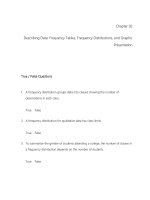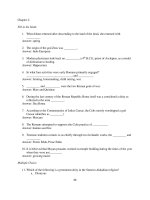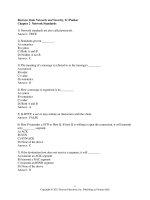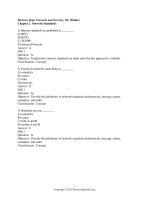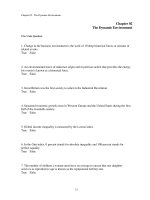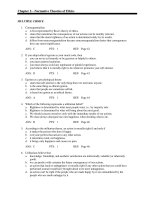Business government and society a managerial perspective text and cases 13th edition steiner test bank
Bạn đang xem bản rút gọn của tài liệu. Xem và tải ngay bản đầy đủ của tài liệu tại đây (115.72 KB, 41 trang )
Chapter 02 - The Dynamic Environment
Chapter 02
The Dynamic Environment
True / False Questions
1. Change in the business environment is the work of 10 deep historical forces or streams of
related events.
True False
2. An environmental force of unknown origin and mysterious action that provides the energy
for events is known as a historical force.
True False
3. Great Britain was the first society to usher in the Industrial Revolution.
True False
4. Sustained economic growth arose in Western Europe and the United States during the first
half of the twentieth century.
True False
5. Global income inequality is measured by the Lorenz index.
True False
6. In the Gini index, 0 percent stands for absolute inequality and 100 percent stands for
perfect equality.
True False
7. The number of children a woman must have on average to ensure that one daughter
survives to reproductive age is known as the replacement fertility rate.
True False
2-1
Chapter 02 - The Dynamic Environment
8. Although the global population growth is slowing, it will be the highest in the most
developed regions.
True False
9. Liberalization refers to the creation of networks of human interaction that span worldwide
distances.
True False
10. In the international arena, the nation state is an actor having a ruling authority, citizens,
and a territory with fixed borders.
True False
11. The nation-state is the unit of human organization in which individuals and cultural
groups can influence their circumstances and future.
True False
12. A set of reinforcing beliefs and values that constructs a worldview is known as an
ideology.
True False
13. The economic environment consists of forces that influence market operations, including
overall economic activity, commodity prices, interest rates, currency fluctuations, wages,
competitors' actions, and government policies.
True False
14. A Web site open to collaborative editing by multiple individuals is known as a blog.
True False
2-2
Chapter 02 - The Dynamic Environment
15. Values based on assumptions of security and affluence are known as postmaterialist
values.
True False
16. A form of government requiring popular sovereignty, political liberty, and majority rule is
the androcracy.
True False
17. Soft law refers to the voluntarily adopted guidelines for corporate behavior derived from
emerging norms and standards in international codes, declarations, and conventions.
True False
18. Economic activity is a geophysical force with power to change the natural environment.
True False
19. The Living Planet Index measures the human consumption of the renewable natural
resources.
True False
20. The employees of a business are a part of its external environment.
True False
2-3
Chapter 02 - The Dynamic Environment
Multiple Choice Questions
21. A plausible story of the future based on assumptions about how current trends might play
out is known as a:
A. proposition.
B. scenario.
C. historical force.
D. premise.
22. _____ is an economic policy of lowering tariffs and other barriers to encourage trade.
A. Liberalization
B. Deregulation
C. Democratization
D. Marketization
23. An environmental force of unknown origin and mysterious action that provides the energy
for events is known as a:
A. proposition.
B. scenario.
C. historical force.
D. premise.
24. Which of the following statements about historical forces is true?
A. It is of known origin.
B. It is divided into six separate but related forces.
C. It is a social force.
D. It causes a distinct chain of events.
25. Which of the following statements about the Industrial Revolution is true?
A. It started in the late 1800s.
B. It first started in the United States.
C. It transformed the agrarian economies into industrial economies.
D. It did not require any specific conditions to be present.
2-4
Chapter 02 - The Dynamic Environment
26. Which of the following situations contributed to the Industrial Revolution?
A. Society that was low on capital and labor
B. Closed society
C. Society that encouraged individual initiative
D. Inadequate transportation
27. Using this statistical measure of global income inequality, inequality becomes greater as
the percentage figure rises toward 100.
A. Human Development Index
B. Robin Hood index
C. Gini index
D. Lorenz index
28. The Gini index ranges between:
A. 0 to -1.
B. 0 percent to 100 percent.
C. -1 to +1.
D. 1 percent to 50 percent.
29. Which of the following statements regarding the Gini index is true?
A. Zero percent stands for absolute equality.
B. It is a statistical measure of complexity.
C. Fifty percent represents absolute inequality.
D. Inequality reduces as the percentage figure rises toward 100.
30. According to the Gini index, the cause of most of the rise in world income inequality is
a(n):
A. growing gap between the peoples of rich and poor nations.
B. increasing trend toward liberalization.
C. growing separation of rich and poor within nations.
D. transition from high to low fertility in nations.
2-5
Chapter 02 - The Dynamic Environment
31. The Human Development Index scale ranges from:
A. 0 to -1.
B. 0 to 1.
C. -1 to +1.
D. -5 to 0.
32. Which of the following is a category used by the HDI to measure the development of
nations?
A. Longevity
B. Flexibility
C. Resilience
D. Dynamism
33. According to the 2010 United Nations Development Programme's Human Development
Report, which of the following countries has the highest human development in the world?
A. The United States
B. Canada
C. Norway
D. Mexico
34. _____ is calculated as the number of children a woman must have on average to ensure
that one daughter survives to reproductive age.
A. Sub-replacement fertility
B. Net reproduction rate
C. Total fertility rate
D. Replacement fertility rate
35. Which of the following is most likely to drive future population changes?
A. High fertility
B. Low mortality
C. Stable fertility
D. Zero migration
2-6
Chapter 02 - The Dynamic Environment
36. Which of the following is true regarding the implications of the current population trend?
A. The global population growth is rising.
B. The global population growth will be lowest in the least developed countries.
C. The wealth gap between the high-and-low-income countries will narrow down.
D. The global population growth will continue to strain the earth's ecosystem.
37. Which of the following is true regarding the waves of innovation that have taken place
since the beginning of the Industrial Revolution?
A. The first wave of innovation started in 1685.
B. In the first wave of innovation, electricity came into general use.
C. The second wave of innovation began in 1845 and ended in 1900.
D. The second wave of innovation was powered by aviation.
38. Identify the correct statement regarding the waves of innovation that have taken place
since the beginning of the Industrial Revolution.
A. The first wave of innovation lasted for about 50 years.
B. The second wave of innovation had a time length of 65 years.
C. Thus far, the waves of innovation have been divided into seven distinct phases.
D. So far, the general trend has been the shortening of successive waves.
39. The invention of the _____ in the late 1700s and its widespread use beginning in the early
1800s triggered the Industrial Revolution.
A. printing press
B. new iron-making method
C. waterwheel
D. steam engine
40. Globalization is:
A. an economic metamorphosis that started in England in the late 1700s.
B. the creation and maintenance of a disparate economic relationship between states.
C. the creation of networks of human interaction that span worldwide distances.
D. a philosophy in which nations promote trade by easing tariff and non-tariff barriers.
2-7
Chapter 02 - The Dynamic Environment
41. ____, especially a few hundred of the largest headquartered in developed nations, are the
central forces of current economic globalization.
A. Transnational corporations
B. Multinational corporations
C. Micro-multinationals
D. International corporations
42. In the international arena, a _____ is an actor formed of three elements: a ruling authority,
citizens, and a territory with fixed borders.
A. pre-national state
B. nation-state
C. citizen state
D. multinational state
43. Which of the following is true regarding the modern nation-state?
A. It is an independent entity which is not administered as part of a local government.
B. It is a sovereign state which is comprised of two or more nations.
C. It is the single dominant ethnic group in a state.
D. It arose in an unplanned way out of the wreckage of the Roman Empire.
44. The _____ is the unit of human organization in which individuals and cultural groups can
influence their circumstances and future.
A. multi-ethnic state
B. citizen state
C. nation-state
D. pre-national state
45. A set of reinforcing beliefs and values that constructs a worldview is called a(n):
A. ideology.
B. theory.
C. realism.
D. philosophy.
2-8
Chapter 02 - The Dynamic Environment
46. Which of the following is NOT an ideology that facilitated the Industrial Revolution?
A. Constitutional democracy
B. Communism
C. Darwinism
D. Social Darwinism
47. Herbert Spencer's idea that evolutionary competition in human society, as well as the
natural world, weeded out the unfit and advanced humanity is known as:
A. neo-Darwinism.
B. neural Darwinism.
C. social Darwinism.
D. quantum Darwinism.
48. _____ is the belief that sacred authority called for hard work, saving, thrift, and honesty as
necessary for salvation.
A. Positivism
B. Protestant ethic
C. Functionalism
D. Confucian ethic
49. Which of the following fulfills the human need for concepts and categories of meaning
that explain daily life?
A. Paradigms
B. Reality
C. Ideology
D. Subjective beliefs
50. The _____ environment consists of forces that influence market operations, like
commodity prices and interest rates.
A. economic
B. technological
C. cultural
D. legal
2-9
Chapter 02 - The Dynamic Environment
51. Which of the following is considered to be the bedrock of economic globalization?
A. Monopoly
B. Foreign direct investment
C. Oligopoly
D. Trade liberalization
52. _____ is a philosophy in which nations promote trade by easing restrictions, including
both tariff and non-tariff barriers.
A. Foreign direct investment
B. Trade liberalization
C. Monopoly
D. Oligopoly
53. _____ refers to capital investment by private firms outside their home countries.
A. Foreign direct investment
B. Foreign portfolio debt investment
C. Foreign portfolio equity investment
D. Capital transfers
54. Technology that is developed on the scale of one-billionth of a meter is known as:
A. picotechnology.
B. microtechnology.
C. nanotechnology.
D. femtotechnology.
55. A Web site open to collaborative editing by multiple individuals is known as a:
A. tag.
B. wiki.
C. blog.
D. forum.
2-10
Chapter 02 - The Dynamic Environment
56. A system of shared knowledge, values, norms, customs, and rituals that are acquired by
social learning is called a:
A. value chain.
B. civilization.
C. culture.
D. value network.
57. Values based on assumptions of security and affluence are known as _____ values.
A. survival
B. self-expressive
C. postmaterialist
D. materialist
58. _____ is a form of government requiring popular sovereignty, political liberty, and
majority rule.
A. Democracy
B. Socialism
C. Communism
D. Liberalism
59. Which of the following is a characteristic of a democracy?
A. Single party rule
B. Universal suffrage
C. Enforced political authority
D. Country is ruled by famous citizens
60. Which of the following is a trend that works in the legal environment to constrain business
behavior?
A. Laws and regulations steadily decline in number and complexity.
B. Legal duties to protect the rights of stakeholders have lessened.
C. Globalization has decreased the complexity of the legal environment by shielding
corporations from the laws of foreign nations.
D. Although requirements of ethical behavior and corporate social responsibility go beyond
legal duty, they are continuously encoded into law.
2-11
Chapter 02 - The Dynamic Environment
61. Voluntarily adopted guidelines for corporate behavior derived from emerging norms and
standards in international codes, declarations, and conventions are called:
A. diplomatic laws.
B. soft laws.
C. case laws.
D. traditional laws.
62. The _____ combines in one measure thousands of population trends among terrestrial,
freshwater, and marine vegetable species.
A. Living Planet Index
B. Ecological Footprint
C. Environmental Performance Index
D. Water Footprint
63. The _____ measures human consumption of renewable natural resources.
A. Living Planet Index
B. Environmental Performance Index
C. Water Footprint
D. Ecological Footprint
64. The _____ is calculated as the total land area, in hectares, required to maintain worldwide
human consumption of food, wood, fiber, energy, and water.
A. Living Planet Index
B. Environmental Impact Index
C. Ecological Footprint
D. Water Footprint
65. Which of the following is an internal business environment?
A. Culture
B. Shareholders
C. Economy
D. Government
2-12
Chapter 02 - The Dynamic Environment
Short Answer Questions
66. What is meant by a historical force?
67. What is the Industrial Revolution?
68. What is a Gini index?
69. What is replacement fertility rate?
2-13
Chapter 02 - The Dynamic Environment
70. Define the term "globalization."
Essay Questions
71. Why did the Industrial Revolution begin in Great Britain?
72. Discuss the problem of global income inequality.
73. What are the factors that will drive future population changes? Discuss the implications of
these population trends.
2-14
Chapter 02 - The Dynamic Environment
74. How has technology impacted societies? What will be the impact of new technologies?
75. Discuss in brief the waves of innovation that have taken place since the beginning of the
Industrial Revolution.
76. Discuss the impact of globalization over the years.
77. Briefly discuss dominant ideologies.
2-15
Chapter 02 - The Dynamic Environment
78. What does the economic environment consist of? Define the terms "trade liberalization"
and "foreign direct investment."
79. How does the cultural environment create change in the relationships between business,
governments, and societies?
80. Discuss the five trends in the legal environment that restrain business behavior.
2-16
Chapter 02 - The Dynamic Environment
Chapter 02 The Dynamic Environment Answer Key
True / False Questions
1. (p. 24) Change in the business environment is the work of 10 deep historical forces or streams
of related events.
FALSE
Difficulty: Easy
2. (p. 25) An environmental force of unknown origin and mysterious action that provides the
energy for events is known as a historical force.
TRUE
Difficulty: Easy
3. (p. 25) Great Britain was the first society to usher in the Industrial Revolution.
TRUE
Difficulty: Medium
4. (p. 25) Sustained economic growth arose in Western Europe and the United States during the
first half of the twentieth century.
FALSE
Difficulty: Medium
2-17
Chapter 02 - The Dynamic Environment
5. (p. 26) Global income inequality is measured by the Lorenz index.
FALSE
Difficulty: Easy
6. (p. 26) In the Gini index, 0 percent stands for absolute inequality and 100 percent stands for
perfect equality.
FALSE
Difficulty: Easy
7. (p. 29) The number of children a woman must have on average to ensure that one daughter
survives to reproductive age is known as the replacement fertility rate.
TRUE
Difficulty: Easy
8. (p. 30) Although the global population growth is slowing, it will be the highest in the most
developed regions.
FALSE
Difficulty: Easy
9. (p. 32) Liberalization refers to the creation of networks of human interaction that span
worldwide distances.
FALSE
Difficulty: Easy
2-18
Chapter 02 - The Dynamic Environment
10. (p. 33) In the international arena, the nation state is an actor having a ruling authority,
citizens, and a territory with fixed borders.
TRUE
Difficulty: Easy
11. (p. 33) The nation-state is the unit of human organization in which individuals and cultural
groups can influence their circumstances and future.
TRUE
Difficulty: Easy
12. (p. 34) A set of reinforcing beliefs and values that constructs a worldview is known as an
ideology.
TRUE
Difficulty: Easy
13. (p. 36) The economic environment consists of forces that influence market operations,
including overall economic activity, commodity prices, interest rates, currency fluctuations,
wages, competitors' actions, and government policies.
TRUE
Difficulty: Easy
14. (p. 38) A Web site open to collaborative editing by multiple individuals is known as a blog.
FALSE
Difficulty: Easy
2-19
Chapter 02 - The Dynamic Environment
15. (p. 40) Values based on assumptions of security and affluence are known as postmaterialist
values.
TRUE
Difficulty: Easy
16. (p. 41) A form of government requiring popular sovereignty, political liberty, and majority
rule is the androcracy.
FALSE
Difficulty: Easy
17. (p. 42) Soft law refers to the voluntarily adopted guidelines for corporate behavior derived
from emerging norms and standards in international codes, declarations, and conventions.
TRUE
Difficulty: Easy
18. (p. 43) Economic activity is a geophysical force with power to change the natural
environment.
TRUE
Difficulty: Easy
19. (p. 43) The Living Planet Index measures the human consumption of the renewable natural
resources.
FALSE
Difficulty: Easy
2-20
Chapter 02 - The Dynamic Environment
20. (p. 44) The employees of a business are a part of its external environment.
FALSE
Difficulty: Easy
Multiple Choice Questions
21. (p. 22) A plausible story of the future based on assumptions about how current trends might
play out is known as a:
A. proposition.
B. scenario.
C. historical force.
D. premise.
Difficulty: Easy
22. (p. 22) _____ is an economic policy of lowering tariffs and other barriers to encourage
trade.
A. Liberalization
B. Deregulation
C. Democratization
D. Marketization
Difficulty: Easy
23. (p. 25) An environmental force of unknown origin and mysterious action that provides the
energy for events is known as a:
A. proposition.
B. scenario.
C. historical force.
D. premise.
Difficulty: Easy
2-21
Chapter 02 - The Dynamic Environment
24. (p. 25) Which of the following statements about historical forces is true?
A. It is of known origin.
B. It is divided into six separate but related forces.
C. It is a social force.
D. It causes a distinct chain of events.
Difficulty: Medium
25. (p. 25) Which of the following statements about the Industrial Revolution is true?
A. It started in the late 1800s.
B. It first started in the United States.
C. It transformed the agrarian economies into industrial economies.
D. It did not require any specific conditions to be present.
Difficulty: Medium
26. (p. 25) Which of the following situations contributed to the Industrial Revolution?
A. Society that was low on capital and labor
B. Closed society
C. Society that encouraged individual initiative
D. Inadequate transportation
Difficulty: Easy
27. (p. 26) Using this statistical measure of global income inequality, inequality becomes greater
as the percentage figure rises toward 100.
A. Human Development Index
B. Robin Hood index
C. Gini index
D. Lorenz index
Difficulty: Easy
2-22
Chapter 02 - The Dynamic Environment
28. (p. 26) The Gini index ranges between:
A. 0 to -1.
B. 0 percent to 100 percent.
C. -1 to +1.
D. 1 percent to 50 percent.
Difficulty: Medium
29. (p. 26) Which of the following statements regarding the Gini index is true?
A. Zero percent stands for absolute equality.
B. It is a statistical measure of complexity.
C. Fifty percent represents absolute inequality.
D. Inequality reduces as the percentage figure rises toward 100.
Difficulty: Medium
30. (p. 27) According to the Gini index, the cause of most of the rise in world income inequality
is a(n):
A. growing gap between the peoples of rich and poor nations.
B. increasing trend toward liberalization.
C. growing separation of rich and poor within nations.
D. transition from high to low fertility in nations.
Difficulty: Easy
31. (p. 28) The Human Development Index scale ranges from:
A. 0 to -1.
B. 0 to 1.
C. -1 to +1.
D. -5 to 0.
Difficulty: Medium
2-23
Chapter 02 - The Dynamic Environment
32. (p. 28) Which of the following is a category used by the HDI to measure the development of
nations?
A. Longevity
B. Flexibility
C. Resilience
D. Dynamism
Difficulty: Easy
33. (p. 28) According to the 2010 United Nations Development Programme's Human
Development Report, which of the following countries has the highest human development in
the world?
A. The United States
B. Canada
C. Norway
D. Mexico
Difficulty: Medium
34. (p. 29) _____ is calculated as the number of children a woman must have on average to
ensure that one daughter survives to reproductive age.
A. Sub-replacement fertility
B. Net reproduction rate
C. Total fertility rate
D. Replacement fertility rate
Difficulty: Easy
35. (p. 30) Which of the following is most likely to drive future population changes?
A. High fertility
B. Low mortality
C. Stable fertility
D. Zero migration
Difficulty: Medium
2-24
Chapter 02 - The Dynamic Environment
36. (p. 30) Which of the following is true regarding the implications of the current population
trend?
A. The global population growth is rising.
B. The global population growth will be lowest in the least developed countries.
C. The wealth gap between the high-and-low-income countries will narrow down.
D. The global population growth will continue to strain the earth's ecosystem.
Difficulty: Medium
37. (p. 31) Which of the following is true regarding the waves of innovation that have taken
place since the beginning of the Industrial Revolution?
A. The first wave of innovation started in 1685.
B. In the first wave of innovation, electricity came into general use.
C. The second wave of innovation began in 1845 and ended in 1900.
D. The second wave of innovation was powered by aviation.
Difficulty: Difficult
38. (p. 31) Identify the correct statement regarding the waves of innovation that have taken place
since the beginning of the Industrial Revolution.
A. The first wave of innovation lasted for about 50 years.
B. The second wave of innovation had a time length of 65 years.
C. Thus far, the waves of innovation have been divided into seven distinct phases.
D. So far, the general trend has been the shortening of successive waves.
Difficulty: Difficult
39. (p. 31) The invention of the _____ in the late 1700s and its widespread use beginning in the
early 1800s triggered the Industrial Revolution.
A. printing press
B. new iron-making method
C. waterwheel
D. steam engine
Difficulty: Medium
2-25


